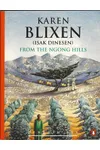Picture a Danish storyteller who spun tales of love, loss, and adventure under the African sun—meet Karen Blixen! Born Karen Dinesen in 1885, she captivated the world with her memoir Out of Africa and haunting short stories, writing as Isak Dinesen. Her lyrical prose and vivid imagination turned her life’s triumphs and tragedies into timeless literature.
From her Kenyan coffee farm to her Danish writing desk, Blixen’s journey was as vibrant as her stories. With a voice that blended romance and realism, she became one of the 20th century’s most unforgettable authors. Let’s dive into her extraordinary life and legacy!
The Making of Karen Blixen
Karen Blixen was born in Rungsted, Denmark, into a well-off family with a love for art and adventure. Raised on tales of exploration, she studied at Copenhagen’s Royal Academy of Fine Arts and began writing early, publishing her first stories in Danish magazines. In 1914, seeking freedom and purpose, she moved to Kenya with her husband, Baron Bror Blixen, to run a coffee plantation. The African landscape and its people sparked her imagination, shaping her literary voice.
Life in Kenya wasn’t easy—her marriage crumbled, and the farm struggled—but these challenges fueled her creativity. After returning to Denmark in 1931, Blixen poured her experiences into writing, adopting the pen name Isak Dinesen to craft stories that blended her reality with myth.
Karen Blixen’s Unforgettable Stories
Blixen’s most famous work, Out of Africa (1937), is a lush memoir of her years in Kenya. It’s not just a travelogue—it’s a love letter to the land, its people, and the fleeting beauty of her life there. Written with poetic grace, it captures her deep connection to Africa and her reflections on freedom and loss.
Under the pseudonym Isak Dinesen, she also penned gothic and fantastical short story collections like Seven Gothic Tales (1934). These tales, rich with mystery and moral complexity, showcase her knack for blending fairy-tale elements with sharp human insights. Another gem, Winter’s Tales (1942), explores themes of fate and sacrifice, earning praise for its elegant storytelling. Her novella Babette’s Feast (1958) celebrates art and generosity, later adapted into an Oscar-winning film.
Blixen’s style is unmistakable: lyrical yet precise, with a storyteller’s flair for weaving myth and reality. Her themes—love, identity, and the clash of cultures—resonate across time, making her work both intimate and universal.
Why Karen Blixen Matters
Karen Blixen’s influence stretches far beyond her books. Out of Africa inspired a 1985 film starring Meryl Streep, bringing her story to millions. Her ability to capture the human spirit in exotic settings paved the way for modern memoirists and travel writers. In Denmark, she’s a literary icon, and her home in Rungsted is now a museum celebrating her legacy.
Blixen’s fearless exploration of gender, culture, and creativity continues to inspire writers and readers. Her stories remind us that beauty and meaning can emerge from even the hardest moments, making her a timeless voice in world literature.
About Karen Blixen
- Born: April 17, 1885, Rungsted, Denmark
- Key Works: Out of Africa, Seven Gothic Tales, Babette’s Feast
- Pen Name: Isak Dinesen
- Awards: Nominated for the Nobel Prize in Literature multiple times
Ready to lose yourself in Karen Blixen’s enchanting world? Grab Out of Africa or Seven Gothic Tales and discover the magic of her storytelling!
